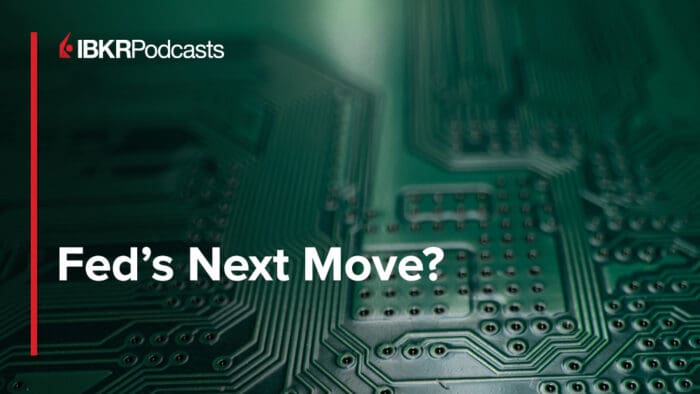In this episode of the Interactive Brokers podcast, Andrew Wilkinson sits down with Chief Strategist Steve Sosnick to analyze the market’s reaction to the recent Trump-Harris debate, discuss the implications of the latest economic data on Fed policy, and explore the dynamics of small caps, tech stocks, and financial sectors. Listen in for insights on how these factors are shaping investor sentiment and market trends.
Summary – IBKR Podcasts Ep. 191
The following is a summary of a live audio recording and may contain errors in spelling or grammar. Although IBKR has edited for clarity no material changes have been made.
Andrew Wilkinson
Welcome to this podcast edition from Interactive Brokers. Joining me to discuss some market odds and ends is Chief Strategist Steve Sosnick. Welcome, Steve.
Steve Sosnick
Hi, Andrew, how are you?
Andrew Wilkinson
Good, thank you. It’s the night, it’s the day after the first Trump-Harris election debate. So Steve, weigh in on the market impact here, as I’m not sure there was much of one.
Steve Sosnick
I don’t think there was much of one. Now, to be fair, I don’t think the market has really been doing much with the election anyway.
Here’s the problem. The race is pretty much too close to call. And on top of it, the Senate and House races are too close to call. Markets generally prefer some sort of division between the parts of government.
They don’t particularly love it when one party has all three, but right now we don’t know who’s going to get any of them.
Even after last night’s debate it’s not clear to what extent, what is widely perceived as a Harris victory, will move the needle too much. And so, the way I looked at it was futures were down a little bit beforehand. They were down a little bit more afterwards. By the time we came in this morning, they were only down modestly. markets had a chance to vote and they really haven’t. And when I think about other aspects of the market, we’ve had this big VIX futures curve pretty much all year, pretty much since the October futures were listed.
Remember, VIX is a 30 day look ahead, so the futures that expire mid-October cover the period in early November that is relevant to the election.
So we’ve had this little bump there, but I think it was more market makers and other people playing defense because there really wasn’t a ton of extra open interest in those futures to push them there.
It was just, you know, let’s price them higher. I know this cause I’ve done such a thing in my previous roles is you play defense, something’s coming down the pipe. So you give it a little extra volatility bump in there. So those weren’t in there.
So the markets really hasn’t done much with it.
Andrew Wilkinson
But the market felt a little bit soggy this morning, so if it wasn’t politics and there was nothing else, then it has to be this morning or the August Consumer Price Index inflation report. What do you think?
Steve Sosnick
That was when the fun started, so to speak. The sound you heard this morning was that of 50 basis point rate cut assumptions falling off a cliff. We had gone away from the 50-50 that we saw a bit on Friday, and I was somewhat skeptical of them anyway, but I think the fact that we had a higher than expected core reading of 0.3 rather than the 0.2 that was expected or the prior number, definitely doesn’t help the Fed’s argument about stable prices.
Remember what changed recently was two things. The July jobs numbers released in August were quite bad. It was one of the precipitating events ahead of the carry trade tantrum, for lack of a better word.
Then we had Jackson Hole later in the month and Chairman Powell reminded us that, you know what, we’re pretty much in the cards for an interest rate cut. But, and the reason being, the stable prices thing, we’re closer. We may not be at our goal, but we’re pretty close. The other part of our dual mandate is maximum employment, and we seem to be moving away from that.
So the market started to focus on it.
Friday’s jobs numbers didn’t help the market’s point of view in terms of a strengthening economy. It did help somewhat in terms of the rate assumptions, but we are, in a sense, we’re economic news because we’re getting a rate cut priced in.
Bad news is bad because you do have to wonder whether the Fed is behind the curve or up to snuff etc. So the news this morning was rather unpleasant. Two things that I took away from it were both on Friday and today, various aspects of wages went up a bit more than expected.
And so labor costs went up a little more than expected for August, which we learned on Friday, 0.4 as opposed to 0.3, which was expected and 0.2, which was prior. And today there weren’t really published expectations for the average hourly earnings and average weekly earnings, but both of them showed a fairly significant rise over last month’s reading.
And so if you’ve got a situation where it was a coin toss after some relatively weak employment numbers. And then you have to focus back again on the stable prices aspect, and then throw in the fact that the Fed kind of doesn’t really love surprising the markets.
Or doing anything that could be construed as overtly political, here we find ourselves with a 25-basis point cut being priced in again.
Andrew Wilkinson
So does that explain a little bit about my next question, which is this great rotation trade. That’s done very well over the summer until it didn’t, but investors moving away from the big tech names to the smaller caps.
The markets seem a little bit data challenged at this point, but what are your thoughts on the small cap sector?
Steve Sosnick
I’ve not been a huge fan of small caps overall. Now the one thing to keep in mind with small caps are the Russell 2000s market cap fits neatly inside of Apple, to pick one.
If enough momentum moves into small caps, they can go up or down just because. That’s just the way they are.
But in terms of a fundamental reasoning behind small caps, one of two things really has to work out if you’re a small cap company, because many of the Russell 2000 companies are unprofitable. And they certainly lack the pricing power that the biggest companies have.
So you either need a strong enough economy such that everybody has some pricing power where everybody can see those results flow to their bottom line, or companies in many cases need access to the capital markets.
So you need much lower rates to really bring down their interest rate costs and their cost structure. 25 basis points here and there isn’t going to do it on the rate front side. We’re looking at a good enough economy, but a soft landing isn’t really what small caps need.
So the rotation can continue. You can see it because of, again, if people just move some of their money out of the big cap tech stocks and into small caps, that can have a profound effect on the performance of them. But in reality, I don’t really see that rush in there.
I don’t really see the fundamental environment to it. And as a friend of mine pointed out recently, a lot of the best small cap companies have been subsumed by private equity over time. So there’s a negative survivor balance in that index. And finally, it’s not as though people are rushing away from mega cap tax.
We’re taping this now on Wednesday afternoon, and the S&P is up about 15 points, having been down about 85 points earlier today. That’s a massive intraday reversal. And a lot of that is just the money came flowing back into the semis, because by the dip in semis. And where Oracle said good things about them and their results, and now we’re waiting to hear what Jensen Huang has to say.
And perhaps the title for today’s discussion is Jensen Huang is greater than Jerome Powell in terms of market impact. Because I do think that really does seem to be the case at the moment. Nobody wants to miss them. Nobody wants to miss a dip in big cap tech stocks, regardless of what we hear about rotation or anything else.
Andrew Wilkinson
Let’s gravitate away from the rotation. The other area that caught my eye this morning for being particularly weak, I’ve kept an eye on financials. That’s an area that you used to market make options in, as you referred to earlier, Steve. What’s going on there? Is this a pure play on interest rates set to decline?
This seems like the interest rate cycle has been flagged for several months now. Why are financials suffering?
Steve Sosnick
Because the people who run them didn’t have particularly great things to say about their business. It’s as simple as that.
Yesterday there was a conference and David Solomon, Head of Goldman Sachs, or DJD-Sol, if that’s your proclivity, if you go clubbing in the Hamptons.
But, he basically said trading results were weaker than the street expected. And, Daniel Pinto, who may or may not be the actual number two or heir apparent to Jamie Dimon, but certainly high enough in their food chain, basically said the analysts are pricing in too much good news for J.P. Morgan.
It’s very hard for financials to do too well if you have companies like Goldman Sachs and J. P. Morgan saying to the street, you’re wrong, you’re too high. Bank of America didn’t have the most constructive comments either.
Again, it’s not just interest rates.
There’s a lot of other things going on in these companies’ business. Particularly the largest banks or, in the case of Goldman, broker/bank. There’s so many moving parts. Yield curve is just one of them.
And to some extent, the inverted yield curve hasn’t hurt them as much because certainly in the case of a Bank of America, in the case of J.P. Morgan, the case of Citi, they’re borrowing short term from their depositors at such low rates that they’ve been able to skirt the worst of that.
Yeah, the stuff they have to borrow in the money market is relatively expensive, potentially relative to lending, but remember also there, they’re not lending at the treasury rate. They’re lending at a spread over treasuries.
And yeah they got a little bit of performance as we saw the yield curve begin to disinvert . Something that I’ve been talking about for a while and I know my colleague Jose Torres has been talking about and the problem there is the recession tends to start after the yield curve disinverts . The inverted yield curve is considered a recessionary signal, but the recession doesn’t tend to start until after.
And so if top management says the street is over optimistic, it’s not going to react well.
Andrew Wilkinson
I hear you well, and loud and clear, Steve. Thank you for joining me today,
Steve Sosnick
My pleasure, Andrew.
Andrew Wilkinson
And we’ll catch up next week. And to the audience, don’t forget, look out for our recent podcasts at IBKR Podcasts and wherever you download your podcasts from. Thanks for joining us.
Steve Sosnick
Thank you.
Disclosure: Interactive Brokers
The analysis in this material is provided for information only and is not and should not be construed as an offer to sell or the solicitation of an offer to buy any security. To the extent that this material discusses general market activity, industry or sector trends or other broad-based economic or political conditions, it should not be construed as research or investment advice. To the extent that it includes references to specific securities, commodities, currencies, or other instruments, those references do not constitute a recommendation by IBKR to buy, sell or hold such investments. This material does not and is not intended to take into account the particular financial conditions, investment objectives or requirements of individual customers. Before acting on this material, you should consider whether it is suitable for your particular circumstances and, as necessary, seek professional advice.
The views and opinions expressed herein are those of the author and do not necessarily reflect the views of Interactive Brokers, its affiliates, or its employees.
Disclosure: Options Trading
Options involve risk and are not suitable for all investors. Multiple leg strategies, including spreads, will incur multiple commission charges. For more information read the "Characteristics and Risks of Standardized Options" also known as the options disclosure document (ODD) or visit ibkr.com/occ


















Join The Conversation
If you have a general question, it may already be covered in our FAQs. If you have an account-specific question or concern, please reach out to Client Services.